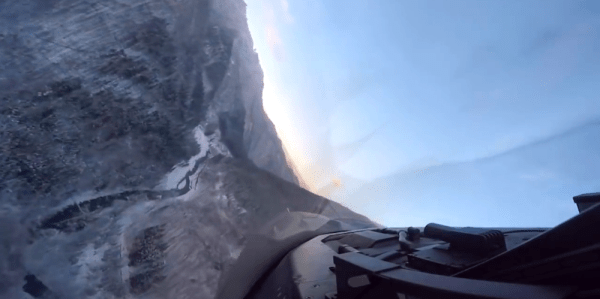

If there’s one thing better than watching a low-level fly-by from the ground, it’s watching from the pilot’s perspective.
That’s the gist of this fantastic footage of a U.S. Air Force F-16 conducting low-flying training in Japan. Released by the 35th Fighter Wing stationed at Misawa Air Base, the cockpit video captures the aircraft careening across the frozen landscape.
Sure, it’s not the same was watching aircraft scream through the unusual network of deep valleys in the United Kingdom known as the “Mach Loop,” but the footage is pretty titillating nonetheless. More importantly, as the Aviationist’s David Cenciotti points out, it’s a nice reminder of how essential these maneuvers can be under wartime conditions:
During normal training activities, flying lower than 2,000 feet can be useful when weather conditions are such to require a low-level leg to keep visual contact with the ground and VMC (Visual Meteorological Conditions). However, it’s when they are committed to the real stuff, including special operations, reconnaissance, Search And Rescue, troops or humanitarian airdrops in troubled spots around the world, that pilots may need to fly at ultra-low altitudes to prevent detection or to survive an engagement by enemy fighter planes or missiles.
Indeed, the casual observer of U.S. military operations abroad likely doesn’t consider the need for nimbleness that aircraft face in enemy territory. After all, the campaigns against the Taliban, Al Qaeda, and ISIS in Afghanistan, Iraq, and Syria have been largely marked by U.S. air supremacy: a non-stop downpour of munitions, with the occasional (lol) air-to-air kill.
But with the DoD increasingly focused on looming threats from Russia in Eastern Europe and North Korea in the Pacific, concerns about air defense and air superiority are back on the table. A November 2017 assessment by the Congressional Research Service noted that the North Korean Air Force possesses a fleet of 1,300 Soviet-era aircraft — as well as “a dense, overlapping air defense system of SA-2, SA-3, and SA-5” surface-to-air missile batteries — challenges that haven’t really factored into the Global War on Terror.
“In theatre [Afghanistan or Iraq], we normally operate at higher altitudes. However, even in the most complex scenarios, flying low remains an option when you need to evade threats,” one Italian Air Force pilot told The Aviationist. “[But] even more so when you fly the Tornado, an aircraft that has been designed to fly at treetop altitude: terrain masking is an option you can rely on.”
Smart, and interesting! The 35th Fighter Wing needs a new soundtrack, though:
